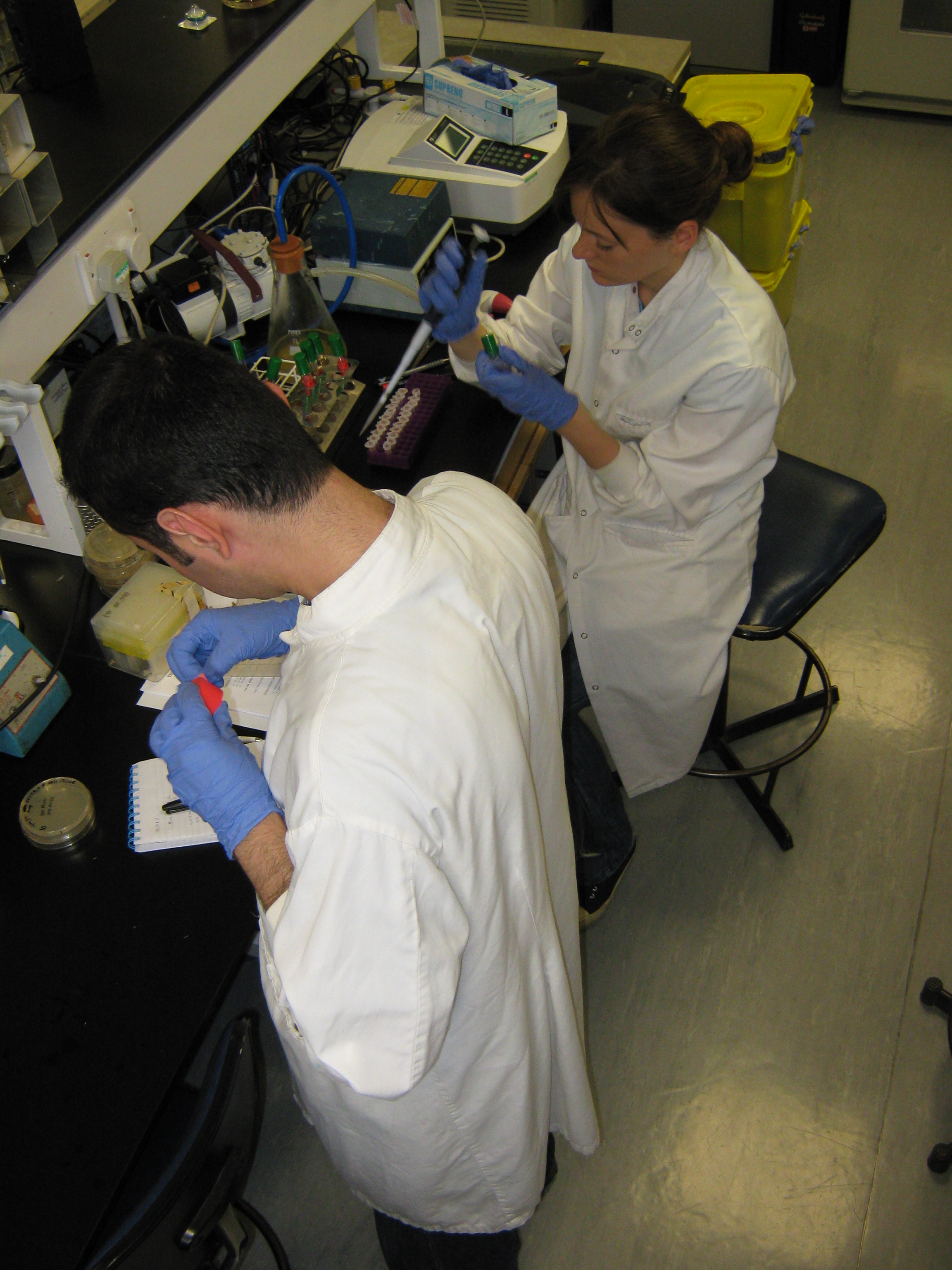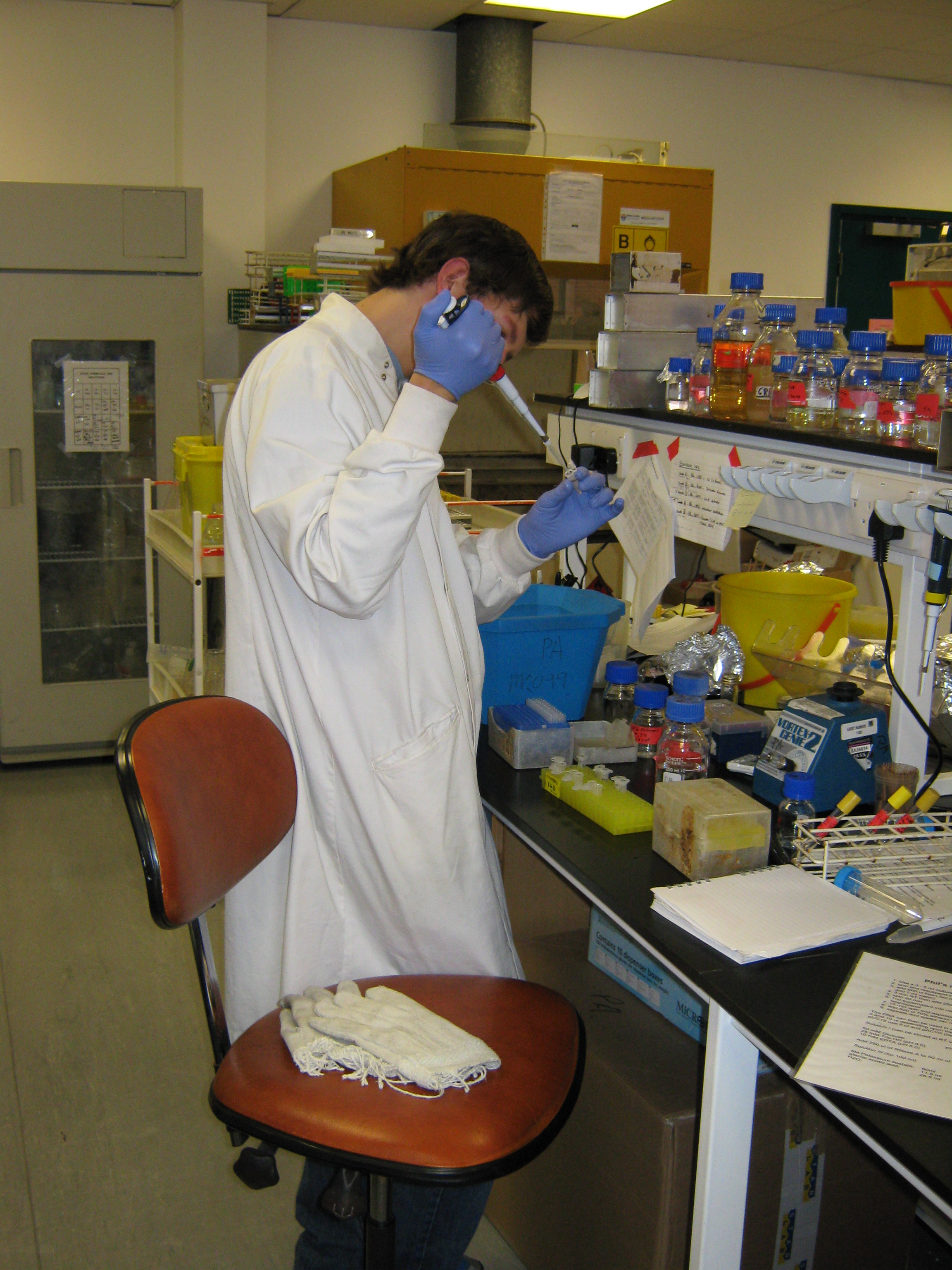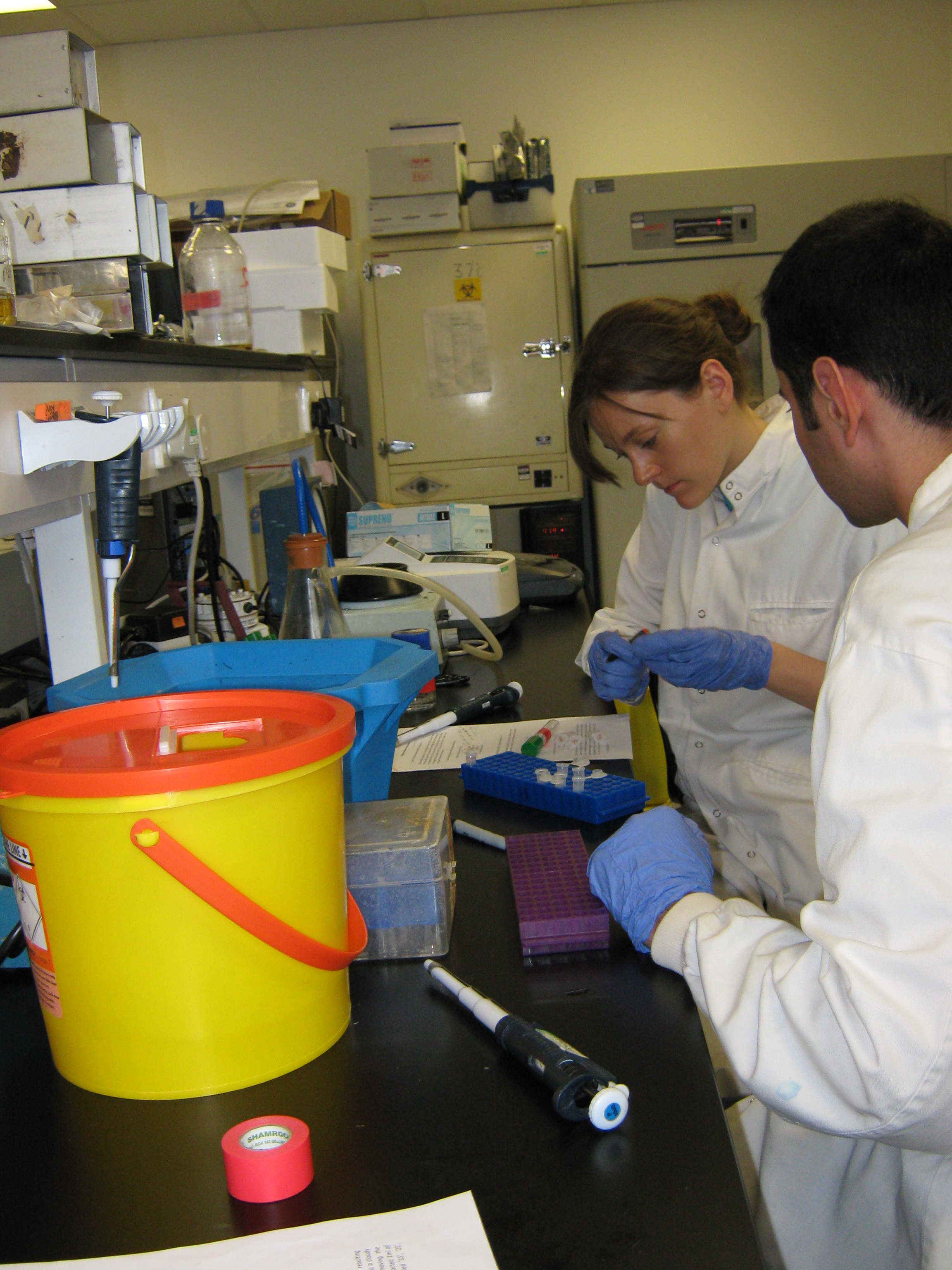Team:Newcastle/Labwork/20 August 2009
From 2009.igem.org
Formal Lab Session - 20th August 2009
Overview
- Metal Sensor Team - carried out mini-preps of BBa_J33206 BioBrick for the three colonies picked and then digested these mini-preps for analysis/
- Stochastic Switch Team - performed mini-preps of the 5 BioBricks which were transformed in E. coli in yesterday's experiment
Metal Sensor Team
Introduction
In yesterday's lab session, the metal sensor team inoculated 3 tubes of 3ml LB with the three transformant E.coli cultures grown on the LB + ampicillin plates (i.e. the E.coli bacteria which had taken up the BBa_J33206 DNA). In addition, 0.5ml of each of these three solutions was used to innoculate 3 flasks containing 50ml LB each. The initial inoculations of 3ml LB solutions is for today's mini prep; the subsequent inoculations of 50ml LB solutions is for today's midi prep.
Today, the team hope to firstly carry out a mini prep for the three transformant cultures. Secondly, it is intended that restriction enzyme digests are carried out on a sample of all three culture plasmids along with DNA gel electrophoresis to determine whether the transformed DNA is in fact the BBa_J33206 BioBrick. Thirdly, if time permits, the team hope to carry out a midi prep of the plasmids for later cloning. If all of these steps do not get completed today, they can resumed tomorrow.
Practical Outline
The Metal Sensing team hope to carry out the following tasks today:
- Conduct a mini-prep of the plasmids contained within the three transformant E.coli cultures (i.e. plasmid pSB1A3 containing BBa_J33206).
- Carry out restriction digests on these plasmids using EcoRI and PstI.
- Run both the undigested and digested plasmids on agarose gel in DNA gel electrophoresis.
- Conduct midi-preps of the plasmids if gel results are positive.
Procedure
Despite having plans to carry out all four procedures listed above, only the following occurred today:
- The mini-preps were conducted
- Restriction enzyme digests were carried out.
- 0.8% Agarose gel made up.
1) Mini-Preps for the E.coli containing BBa_J33206
To carry out this procedure Dr. Aldridge's Mini-Prep protocol was used.
There were a few changes to the protocol:
- Step 1 requires that 3-5ml of culture grown overnight be used for the mini-prep. In actual fact we started this procedure with 2.5ml of culture; this is because the team inoculated 3ml of LB for each transformant grown on the plate and then used 0.5ml of those cultures to further inoculate 50ml of LB each (for the future midi-preps).
- In addition to this, the 2.5ml of LB for each transformant culture was split into 2 Eppendorf tubes (meaning a total of six Eppendorf tubes because three cultures were extracted from the ampicillin LB plates). This decision was taken because it enables the smaller yet faster centrifuge to be used.
- During the whole procedure the 3 x 2.5ml of culture remained divided into 2 Eppendorf tubes; they were never recombined. This proved helpful as it allowed one Eppendorf tube for each culture to hold undigested plasmid DNA and the second Eppendorf Tube for each culture to hold digested plasmids (once restriction enzymes were added). This can be carried out because the plasmid pSB1A3 has a high copy number.
Apart from these changes to the protocol, the rest of the steps proceded as normal.
Summary of Procedure
- 2.5ml of overnight culture of each of the three transformant E.coli cells were split into two Eppendorf tubes and spun down for 3 minutes at 13,000rpm. They were then resuspended in 300ul of Solution I+RNase.
- 600 ul of fresh Solution II was then added to the 6 Eppendorf tubes and left on the bench for 5 minutes. Once this time had elapsed 250 ul of Solution III was added to each of the 6 Eppendorf tubes.
- These 6 Eppendorf tubes (3 cultures divided into 2 Eppendorf tubes each) were then spun for 20 minutes at 13,000 rpm.
- 1ml supernatant was then extracted from all 6 Eppendorf tubes and placed into 6 new tubes. 600 ul Isopropanol was added to each of the new tubes and the Eppendorf tubes spun for 15 minutes at 13,000 rpm. The samples were then aspirated.
- The team then added 500 ul 70% ethanol to all 6 tubes and spun the tubes for 5 minutes at 13,000 rpm. These were then aspirated (using the aspirator) and then applied to a speed vac. Once completely dried, 50ul of water was added to each tube.
The six Eppendorf tubes were then transferred to the -20°C freezer for storage
2) Restriction Enzyme Digests on plasmids containing BBa_J33206
As it stands each of the three E.coli transformant cultures have been split into two Eppendorf tubes and mini-plasmid preps carried out on both tubes for each culture. Therefore for each of the 3 E.coli cultures containing BBa_J33206, the first Eppendorf tube was left untouched whilst the second Eppendorf tube was used in the restriction digests. The protocol used was Dr. Aldridge's Restriction Enzyme Digest Protocol.
Summary of Procedure
To three new Eppendorf tubes the following solutions were added:
- 0.5 ul EcoRI enzyme
- 0.5 ul PstI enzyme
- 2 ul 10x Buffer H
- 7 ul of sterile water
To each of the tubes, 10 ul plasmid DNA from each of the three cultures (from the mini-preps) was added.
The three Eppendorf tubes containing the plasmid DNA plus restriction enzyme mixtures were transferred to a 37°C incubator for 1 hour.
3) Preparing the 0.8% Agarose Gel
This procedure was carried out by first of all preparing the agarose gel and also by preparing the electrophoresis trays. Once these steps were completed the gel was then poured (all of these steps covered in the DNA Gel Electrophoresis protocol)
The only changes to the protocol were:
- Two rows of wells were placed in the gel instead of one. This was to accomodate both the DNA samples from the Metal Sensor team and the Stochastic Switch team.
- Once the gel had been poured and set, the gel comb was not removed neither was the gel transferred to the electrophoresis apparatus. Instead the gel within the tray, with combs still in place, was sprinkled with 1 x TAE buffer and wrapped up carefully in cling film. The gel was then transferred to the fridge for use the next day.
Stochastic Switch Team
Summary
Today we did minipreps from yesterday's overnight cultures and also discovered the results from our two leftover plates for biobricks C00178 and C0062. C00178 had sufficient colonies that we could do overnights (3ml LB+Amp) however C0062 had yet again failed to transform. We followed the miniprep protocol and froze the crude extract in the -20 ready for restriction digests tomorrow. We saved all the plated that we had used and labelled them in the fridge. Today we also had a lab clearout/organisation so that stocks can be easily found in the space we have in the fridge/freezers.
|
| |||||||||||||||||||||||||||||||||||||||||||||||||||||||||||||||||||||||||||||||||||||||||||||||||
|
| |||||||||||||||||||||||||||||||||||||||||||||||||||||||||||||||||||||||||||||||||||||||||||||
News
Events
- 20 – 21 June 2009 - Europe workshop (London)
- 23 – 24 June 2009 - UK iGEM meetup (Edinburgh)
- 23 October Practice Presentation (Newcastle)
- 23 October T-shirts are ready
- 27 October Practice Presentation (Sunderland)
- 27 October Poster is ready
- 30 October – 2 November 2009 - Jamboree (Boston)
Social Net
 "
"





